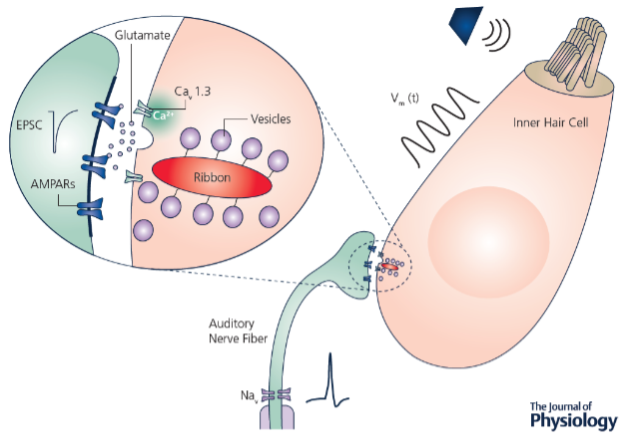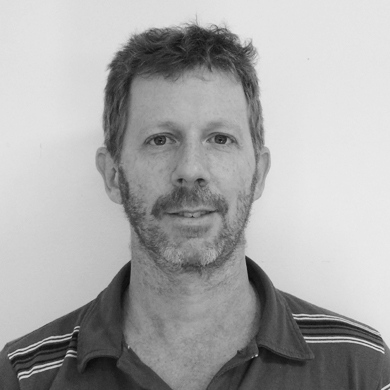In our laboratory we investigate mechanisms of synaptic transmission in hair cells of the mammalian inner ear. The cellular basis of sound enconding are studied in both normal and pathological conditions, focusing on the ribbon synapse between inner hair cells and neurons of the auditory nerve (see image on the right). This is the first synapse in the auditory pathway and it is responsible for relaying to the brain multiple features of the acoustic environment. In addition, we are interested in determining the role of other synapses that exist in hair cells both during development and in mature stages.

Lab Members
Tais Castagnola
PhD student(co-mentored with Dr. Carolina Wedemeyer)
Camila Catalano Di Meo
Biology student, University of Buenos Aires

Selected Publications
1. Encoding sounds in the cochlea: from receptor potential to afferent discharge
M. Rutherford, H. von Gersdorff, J.D. Goutman.
The Journal of Physiology (2021) 599(10), 2527-2557.
2. Noise exposure triggers changes in synaptic function of mammalian hair cells
L. Boero, S. Payne, M. E. Gómez-Casati, M. Rutherford, J. D. Goutman.
Frontiers in Synaptic Neuroscience (2021) 13:740368.
3. Synaptic contributions to cochlear hair cell Ca2+ dynamics
M. Moglie, D. Wengier, A. B. Elgoyhen, J. D. Goutman.
The Journal of Neuroscience (2021) 41, 6812-6821.
4. Compartmentalization of antagonistic Ca2+ signals in developing cochlear hair cells.
Marcelo Moglie, Paul A. Fuchs, A. B. Elgoyhen, J. D. Goutman.
Proc. Natl Acad. Sci. (2018), 115 (9): E2095-E2104.
5. Otoferlin acts as a Ca2+ sensor for vesicle fusion and vesicle pool replenishment at auditory hair cell ribbon synapses.
N. Michalski, J. D. Goutman, S. M. Auclair, J. Boutet de Monvel, M. Tertrais, A. Emptoz, A. Parrin, S. Nouaille, M. Sachse, A. Bahloul, R. B. Sutton, P. Avan, S. S. Krishnakumar, J. E. Rothman, D. Dulon, S. Safieddine, C. Petit.
eLife (2017) Nov 7;6. pii: e31013.
6. Mechanisms of synaptic depression at the hair cell ribbon synapse that support auditory nerve function.
Juan D. Goutman.
Proc. Natl Acad. Sci. (2017) 114, 9719-9724.
Research Goals
1) Physiological and biophysical aspects of the inner hair cell ribbon synapse with auditory nerve neurons.
Within the cochlea, hair cells are responsible for transducing sound waves into electrical signals. The information conveyed in these signals is relayed to the brain through synapses between hair cells and auditory nerve neurons. Responses to acoustic stimuli have been recorded in auditory nerve neurons for decades now, using simple pure tones sounds, at different frequencies, sustained or instantaneous, frequency- or amplitude- modulated, etc. Due to experimental restrictions, these studies analyzed the cochlear function from auditory nerve responses but lacked the possibility to directly interrogate hair cells role. Our long-term goal is to investigate the cellular basis of sound encoding in the cochlea, and specifically contribute to determine synaptic mechanisms. It is important to emphasize that the techniques that are used for these experiments (simultaneous patch-clamp recordings in hair cells and boutons of auditory nerve neurons) provide high quality data on the operation of this synapse, and is mastered by few labs around the world.
More recently, we have described that this synapses can undergo different forms of short term plasticity and one of our goals for coming years is focused on determining its mechanisms and roles.
2) The effect of acoustic trauma on the function of hair cell synapses. In collaboration with Dr. M. Eugenia Gómez-Casati, Instituto de Farmacología, Fac. Medicina, UBA.
Acoustic trauma is one of the main origins of hearing deficits in industrialized countries. The consequences of loud noise exposure on hair cell morphology has been described in the last decades, but functional characterization still lack. This project intends to determine how is the inner ear affected by trauma, and specifically investigate the consequences on the hair cell ribbon synapse operation. The experimental basis for this study are electrophysiological techniques mainly tracking capacitance changes as a proxy for vesicular release in hair cells, both in control and noise exposed mice.
Also in collaboration with Mark Rutherford from Washington University (St Louis Missouri), we are currently investigating the cellular basis of the injury produced on auditory nerve neurons by noise over-exposure. Thus, the composition of AMPA receptors subunits is under investigation, along with the determination of their Ca2+ permeability. We will test the hypothesis indicating that Ca2+ is responsible for producing injury by excitotoxicity.
3) Ca2+ ion dynamics at the olivocochlear synapse in hair cells of the cochlea.
Hair cells relay acoutic information to the brain through its ribbon synpase, but they also receive an inhibitory input that is responsible of controlling their excitability. One of the unique features about this synapse is that it is cholinergic (Acetylcholine is the main transmitter), but it is inhibitory and mediated by two special nicotinic subunits: alpha9 and alpha10. The lab of Belén Elgoyhen at INGEBI has extensively characterized this synapse, and now collaborate with us in investigating the mechanisms of Ca2+ entry, localization and dynamics. We typically perform electrophysiological recordings together with Ca2+ imaging assays in hair cells, using Ca2+-sensitive fluorescent probes and fast detection methods.
Funding
1. FONCyT PICT 2019 – 00964 “Functional changes in the inner ear after acoustic trauma”.
2. In collaboration with Mark Rutherford, Washington University (EEUU) “Excitation and excitotoxicity in type I cochlear afferents: synaptic structure and function”.
3. PIP 2021-2023 “Efectos del trauma acústico sobre la función sináptica coclear”.
Former Members
Marcelo Moglie, PhD student. Currently postdoc at Crick Institute, Londron UK
Luis Boero, PhD student. Currently postdoc at Harvard University, Boston USA

- 1999. Lic. en Cs. Biológicas. FCEN, UBA.
- Ph. D. at UBA, Department of Biological Sciences.
- 2001. International Visiting Fellow at the lab of Ariel L. Escobar. Texas Tech University-Health Science Center. Lubbock, TX, USA.
- 2002. Visiting student at Dr. Ramón Latorre lab in Centro de Estudios Científicos (CECS) Valdivia, Chile.
- 2004 – 2007. Postdoctoral Fellow. Lab of Elisabeth Glowatzki. Dept. of Otolaryngology – HNS, School of Medicine, Johns Hopkins University.
- 2008 – 2009. Postdoctoral fellow. Dr. Ralf Schneggenburger laboratory. Brain and Mind Institute, School of Life Sciences, Ecole Polytechnique Federale de Lausanne. Switzerland.
- 2009 – 2012. Assistant Researcher CONICET.
- 2012 – 2017 Associate Researcher CONICET.
- 2017. Kavli Foundation NDI Visiting Scientist, at Johns Hopkins University.
- 2018 – present Independent Researcher CONICET.
